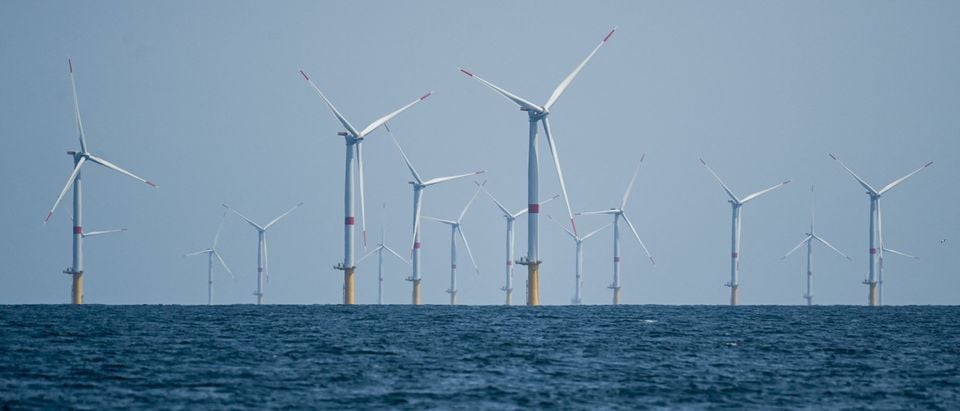Why The Appeal Of Expensive Offshore Wind Projects Is Fading

Table of Contents
Soaring Project Costs and Budget Overruns
The initial promise of offshore wind – clean, abundant energy – is being challenged by the stark reality of escalating costs. Several factors contribute to this financial strain, threatening the viability of many projects.
Inflation and Supply Chain Disruptions
Inflation and global supply chain issues have significantly increased the cost of materials, labor, and transportation for offshore wind projects. This has led to substantial budget overruns and delays.
- Increased Material Costs: The price of steel, crucial for turbine construction and foundation structures, has skyrocketed. Similarly, the cost of rare earth minerals needed for turbine components has also risen sharply.
- Labor Shortages and Increased Wages: Specialized skills are needed for offshore wind construction and installation. A shortage of skilled workers coupled with increased wage demands has driven up labor costs.
- Transportation Challenges: Transporting massive turbine components and other materials to offshore locations is expensive and logistically challenging. Supply chain disruptions have further exacerbated these costs.
- Case Study: The Vineyard Wind project in Massachusetts experienced significant cost overruns due to inflation and supply chain delays, highlighting the vulnerability of large-scale projects to these factors. This illustrates the risks associated with offshore wind cost estimations.
Underestimation of Engineering and Installation Challenges
The complex engineering and installation challenges associated with offshore wind farms are often underestimated in initial project assessments. This leads to significant cost escalations and project delays.
- Unpredictable Weather Conditions: Offshore construction is highly susceptible to adverse weather conditions, which can lead to delays and increased costs.
- Challenging Seabed Conditions: Unexpected seabed conditions, such as stronger currents or softer soil than anticipated, can require significant design modifications and add substantial costs.
- Scale and Complexity of Projects: The sheer scale of offshore wind farms necessitates meticulous planning and execution. Any unforeseen issue can have cascading effects on the entire project timeline and budget.
- Example: Several projects have faced delays due to unexpected seabed conditions requiring foundation redesign, showcasing the importance of thorough offshore wind installation and offshore wind engineering planning. These delays contribute significantly to the rising offshore wind cost.
Environmental Concerns and Public Opposition
Beyond the financial challenges, environmental concerns and public opposition are playing an increasingly significant role in hindering the progress of offshore wind projects.
Impact on Marine Ecosystems
Offshore wind farms can have potentially significant impacts on marine ecosystems. These impacts must be carefully assessed and mitigated.
- Noise Pollution: The construction and operation of wind turbines generate noise pollution that can affect marine mammals such as whales and dolphins.
- Habitat Disruption: The construction of wind farms can disrupt seabed habitats, affecting sensitive species.
- Bird and Bat Mortality: Collisions with turbine blades pose a risk to birds and bats.
- Mitigation Strategies: Ongoing research explores various mitigation strategies, including noise reduction technologies and careful site selection to minimize impacts on marine ecosystems. Addressing these offshore wind environmental impact concerns is critical.
Visual Impacts and Public Perception
The visual impact of large-scale offshore wind farms on coastal landscapes is a major concern for many communities. This can lead to public opposition and delay project approvals.
- Visual Impact Assessments: Comprehensive visual impact assessments are needed to evaluate the aesthetic effects of wind farms on coastal views.
- Public Consultations: Meaningful public consultations are vital to address concerns and build support for projects.
- Addressing Public Concerns: Developers need to engage with local communities and proactively address aesthetic concerns to foster acceptance. Ignoring public perception can lead to prolonged delays and ultimately, project failure. The offshore wind visual impact is becoming a key factor in project feasibility.
Emergence of More Cost-Effective Renewable Energy Alternatives
The rising costs and environmental concerns of offshore wind are further compounded by the increasing competitiveness of other renewable energy sources.
On-Shore Wind and Solar Power
On-shore wind and solar power are becoming increasingly cost-competitive with offshore wind, offering a lower cost per unit of energy generated.
- Cost Comparison: The levelized cost of energy (LCOE) for onshore wind and solar is often significantly lower than that of offshore wind.
- Energy Output: Advances in turbine technology and solar panel efficiency are continuously boosting energy production from these sources.
- Environmental Impact: Onshore wind and solar projects generally have a smaller footprint and lower environmental impact than offshore wind farms. The cost comparison between these renewable energy sources is shifting the energy landscape.
Technological Advancements in Energy Storage
Advancements in battery storage technologies are making intermittent renewable energy sources like wind and solar more reliable, reducing the need for costly grid infrastructure upgrades often associated with large offshore wind projects.
- Cost Reductions: Battery storage costs are declining rapidly, making it a more economically viable option for integrating renewable energy into the grid.
- Grid Stability: Energy storage helps to stabilize the grid by providing a reliable source of power during periods of low wind or solar generation.
- Impact on Offshore Wind: The increasing affordability and efficiency of energy storage reduce the reliance on large-scale, expensive offshore wind projects for grid stabilization. These battery technology advancements are directly impacting the viability of offshore wind development.
Conclusion
The appeal of expensive offshore wind projects is diminishing due to a confluence of factors: escalating costs driven by inflation and logistical complexities, growing environmental concerns and public opposition, and the emergence of more cost-effective renewable energy alternatives. While offshore wind remains a crucial part of the transition to a clean energy future, a more pragmatic approach is needed, focusing on cost optimization, environmental stewardship, and a diversified renewable energy portfolio. Careful consideration of these issues is vital for the future viability and success of expensive offshore wind projects. The industry must address the rising costs and environmental concerns to regain the appeal of expensive offshore wind projects and ensure its continued role in the global energy transition.

Featured Posts
-
 Investigation Launched After Death Threat Against Nigel Farage By Afghan Migrant
May 03, 2025
Investigation Launched After Death Threat Against Nigel Farage By Afghan Migrant
May 03, 2025 -
 Au Dela De La Douleur Emmanuel Macron Emu Face Aux Victimes De L Armee Israelienne
May 03, 2025
Au Dela De La Douleur Emmanuel Macron Emu Face Aux Victimes De L Armee Israelienne
May 03, 2025 -
 Riot Fest 2025 Green Day And Weezer Lead The Charge
May 03, 2025
Riot Fest 2025 Green Day And Weezer Lead The Charge
May 03, 2025 -
 April 17 2025 Daily Lotto Winning Numbers
May 03, 2025
April 17 2025 Daily Lotto Winning Numbers
May 03, 2025 -
 Fortnite Cosmetic Refunds A Sign Of Future Changes
May 03, 2025
Fortnite Cosmetic Refunds A Sign Of Future Changes
May 03, 2025
Latest Posts
-
 13 Kerja Sama Baru Hasil Pertemuan Presiden Erdogan Dan Indonesia
May 03, 2025
13 Kerja Sama Baru Hasil Pertemuan Presiden Erdogan Dan Indonesia
May 03, 2025 -
 Obsuzhdenie Mer Po Borbe S Torgovley Lyudmi V Sogdiyskoy Oblasti
May 03, 2025
Obsuzhdenie Mer Po Borbe S Torgovley Lyudmi V Sogdiyskoy Oblasti
May 03, 2025 -
 Hasil Kunjungan Presiden Erdogan Ke Indonesia 13 Kerjasama Ri Turkiye
May 03, 2025
Hasil Kunjungan Presiden Erdogan Ke Indonesia 13 Kerjasama Ri Turkiye
May 03, 2025 -
 Protivodeystvie Torgovle Lyudmi Poslednie Novosti Iz Sogda
May 03, 2025
Protivodeystvie Torgovle Lyudmi Poslednie Novosti Iz Sogda
May 03, 2025 -
 Borba S Torgovley Lyudmi V Sogde Itogi Obsuzhdeniya
May 03, 2025
Borba S Torgovley Lyudmi V Sogde Itogi Obsuzhdeniya
May 03, 2025
